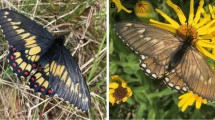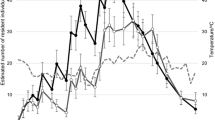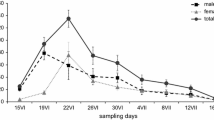Abstract
A population of Parnassius mnemosyne L., an endangered butterfly species, was studied for two seasons by mark–release–recapture (MRR) techniques in the Litovelské Pomoraví Protected Landscape Area, Czech Republic. There were four distinct colonies in the area; the MRR data indicate that the largest colony contained over 1000 adult males during peak flight in 1996 suggesting that the area harbours one of the largest populations of the species in the Czech Republic. The detected rate of intercolony movements showed that the individual colonies were not genetically isolated, but the interchange of individuals was limited. Capture sex ratio and estimated sex ratios were both consistently male-biased. We suggest that this might be caused by different behaviour of the sexes which renders the males more catchable: the females spent most of their time either egg laying or resting, which makes them inconspicuous compared to the patrolling males. Preferred oviposition sites were open, sunny patches such as forest clearings which may be due to different hostplant quality compared to hostplants under closed canopy. The heliophily of the species and the dependency of females on open oviposition sites render the butterfly vulnerable due to a decline in coppice management and replacement of fine mosaic of sunny and shady patches by even-aged forest stands.
Similar content being viewed by others
References
Aagaard, K. and Hanssen, O. (1992) Population studies of Parnassius mnemosyne (Lepidoptera) in Sunndalen, Norway. In: Future of Butterflies in Europe: strategies for survival. Proceedings of an international congress, held at Wageningen during April 12-15, 1989 (T. Pavlicek-van Beek, A.H. Ovaa and J.G. van der Made, eds) pp. 160–6. Wageningen: Department of Nature Conservation, Agricultural University, Wageningen.
Adamski, P. and Witkowski, Z. (1999) Wing deformation in an isolated Carpathian population of Parnassius apollo (Papilionidae: Parnassiinae). Nota lepid. 22, 67–73.
Bergmann, K.O. (1999) Habitat utilisation by Lopinga achine (Nymphalidae: Satyrinae) larvae and ovipositing females: implications for conservation. Biol. Conserv. 88, 69–74.
Cook, L.M., Brower, L.P. and Croze, H.J. (1967) The accuracy of a population estimation from multiple recapture data. J. Anim. Ecol. 36, 57–60.
Čaputa, A. (1992) Jason dymnivkový. In: Červenákniha ohrožen-ých a vzácných druhov rastlín a živoč´íchov ČSFR. 3: Bezstavovce (L. Škapec, ed.) pp. 106–7. Bratislava: Príroda. (Clouded apollo. In: Red Data Book of the Endangered and Rare Plants and Animals of ČSFR 3: Invertebrates. In Slovak.)
Čízek, O. (1991) Lesy Litovelského Pomoravý. In: Oborovýdokument Chráněnékrajinnéoblasti LitovelskéPomoravý(Dokumentace ČÚOP Praha) (B. Šarapatka, ed.) pp. 199–271. Unpublished manuscript, Palacký University, Olomouc. (Forests of Litovelské Pomoraví. In: Conservation documentation of the Litovelské Pomoraví Protected Landscape Area. (Archives ČÚOP, Praha). In Czech.)
Descimon, H. and Napolitano, M. (1992) Genetic management of butterfly populations. In: Future of Butterflies in Europe: strategies for survival. Proceedings of an international congress, held at Wageningen during April 12-15, 1989 (T. Pavlicek-van Beek, A.H. Ovaa and J.G. van der Made, eds) pp. 231–8. Wageningen: Department of Nature Conservation, Agricultural University, Wageningen.
Descimon, H. and Napolitano, M. (1993) Enzyme polymorphism, wing pattern variability and geographical isolation in an endangered butterfly species. Biol. Conserv. 66, 117–23.
Eberhardt, L.L. (1969) Population estimates from recapture frequencies. J. Wildl. mgmt. 33, 28–39.
Ebert, G. and Renwald, E. (1991) Die Schmeterlinge Baden-Wurttembergs. Band 1: Tagfalter I. Stutgart: Verlag Eugen Ulmer.
Feeny, P.P. (1976) Plant apparency and chemical defense. Rec. Adv. Phytochem. 10, 1–40.
Fisher, R.A. (1930) The Genetical Theory of Natural Selection. Oxford: Clarendon Press.
Gall, L.F. (1984) Population structure and recommendations for conservation of the narrowly endemic Alpine Butterfly, Boloria acrocnema (Lepidoptera: Nymphalidae). Biol. Conserv. 28, 111–38.
Greatorex-Davis, J.N., Sparks, T.H., Hall, M.L. and Mars, R.H. (1993) The influence of shade on the butterflies in ridges of coniferised lowland wood in southern England and implications for conservation management. Biol. Conserv. 63, 31–41.
Hammarstedt, O. (1992) Conservation of butterflies in the Nordic countries. In: Future of Butterflies in Europe: strategies for survival. Proceedings of an international congress, held at Wageningen during April 12-15, 1989 (T. Pavlicekvan Beek, A.H. Ovaa and J.G. van der Made, eds) pp. 16–25. Wageningen: Department of Nature Conservation, Agricultural University, Wageningen.
Hanski, I., Pakkala, T., Kuussaari, E. and Lei, G. (1995) Metapopulation of an endangered butterfly in a fragmented landscape. Oikos 72, 21–8.
Hirose, Y. and Takagi, M. (1995) Population dynamics and life history strategies of selected Papilionidae. In: Swallowtail Butterflies: Their ecology and evolution biology (J.M. Scriber, Y. Tsubaki, and R.C. Lederhouse, eds) pp. 107–1113. Gainesville, FL: Scientific Publishers.
Hudec, K., Husák, Š., Janda, J. and Pellantová, J. (1995) Mokrady České republiky - Přehled vodních a mokřad-ních biotopů České republiky (Upravený dotisk 2. verze). Třeboň: Český Ramsarský Výbor. (Wetlands of the Czech Republic - Review of the Aquatic and Wetland Biotopes of the Czech Republic. In Czech.)
Jolly, G.M. (1965) Explicit estimates from capture-recapture data with both death and immigration - stochastic model. Biometrica 52, 225–47.
Konvička, M. (1995) Macrolepidoptera Litovelského Pomoraví. Unpublished MSc. Thesis, Palacký University Olomouc, 192 pp. (Macrolepidoptera of LitovelskéPomoraví. In Czech.)
Kudrna, O. and Seufert, W. (1991) Oekologie und Schutz von Parnassius mnemosyne (Linnaeus, 1758) in der Rhon. Oedippus 2, 1–44.
Kuras, T., Beneš, J., Čelechovský, A., Vrabec, V. and Konvička, M. (manuscript) Review of North Moravian localities of Parnassius mnemosyne L. (Lepidoptera: Papilionidae): Causes of extinction and conservation recommendation. Submitted to Klapalekiana.
Lande, R. and Barrowclough, G.F. (1987) Effective population size, genetic variation, and the use in population management. In: Viable Populations for Conservation (M. E. Soulé, ed.) pp. 87–124. Cambridge: Cambridge University Press.
Lukášek, J. (1997) Dosavadní poznatky z reintrodukce jasoně červenookého (Parnassius apollo) ve Štramberku. Příroda, Praha 2, 28–39. (Current results of the re-introduction of the Apollo Butterfly (Parnassius apollo) at Štramberk, North Moravia. In Czech).
Matsumoto, K. (1985) Population dynamics of the Japanese Clouded Apollo Parnassius glacialis BUTLER (Lepidoptera: Papilionidae). I. Changes in population size and related population parameters for three successive generations. Res. Popul. Ecol. 27, 301–12.
Matsumoto, K. and Suzuki, N. (1995) The nature of mating plugs and the probability of insemination in Japanese Papilionidae. In: Swallowtail Butterflies: Their ecology and evolutionary biology (J.M. Scriber, Y. Tsubaki and R.C. Lederhouse, eds) pp. 145–54. Gainesville, FL: Scientific Publishers.
Meglecz, E., Pecsenye, K., Peregovits, L. and Varga, Z. (1997a) Effects of population size and habitat fragmentation on the genetic variability of Parnassius mnemosyne populations in NE Hungary. Acta zool. Hung. 43, 183–90.
Meglecz, E., Pecsenye, K., Peregovits, L. and Varga, Z. (1997b) Allozyme variation in Parnassius mnemosyne (L) (Lepidoptera) populations in north-east Hungary: variation within a subspecies group. Genetica 101, 59–66.
Meglecz, E., Pecsenye, K., Varga, Z. and Solignac, M. ( 1998) Comparison of differentiation pattern in allozyme and microsatellite loci in Parnassius mnemosyne (Lepidoptera) populations. Hereditas 128, 95–103.
Napolitano, M. and Descimon, H. (1994) Genetic structure of French populations of the mountain butterfly Parnassius mnemosyne L. (Lepidoptera: Papilionidae). Biol. J. Lin. Soc. 53, 325–41.
Novák, I. (ed.) (1997) Catalogue of the Bohemian Lepidoptera. Klapalekiana 33(Suppl.), 1–159.
Novák, I. and Spitzer, K. (1982) Ohroženýsvět hmyzu. Praha: Academia (Endangered World of Insects. In Czech.)
Opravil, E. (1983) ´Údolnýniva v doběhradištní(ČSSR - povodíMoravy a Poodří). Praha: Academia. (Alluvium in Prehistory (ČSSR - the Morava and Odra Floodplains) In Czech.)
Orr, A.G. (1995) The evolution of the sphragis in the Papilionidae and other butterflies. In: Swallowtail Butterflies: Their ecology and evolutionary biology (J.M. Scriber, Y. Tsubaki, and R.C. Lederhouse, eds) pp. 155–64. Gainesville, FL: Scientific Publishers.
Pollock, K.H., Nichols, J.D., Brownie, C. and Hines J.E. (1990). Statistical inference for capture-recapture experiments. Wildl. Monogr. 107, 1–97.
Razowski, J. (1985) Changes in the lepidopterous fauna of Cracow, Poland. Nota Lepidopterol. 8, 65–8.
Renwick, J.A. and Chew, F.S. (1994) Oviposition behavior in Lepidoptera. Ann. Rev. Entomol. 39, 377–400.
Scott, J.A. (1973a) Mating of butterflies. J. Res. Lepid. 11, 99–127.
Scott, J.A. (1973b) Population biology and adult behavior of the Circumpolar Butterfly, Parnassius phoebus F. (Papilionidae). Ent. Scand. 4, 161–8.
Scott, J.A. (1974) Mate-locating behavior of butterflies. Amer. Midl. Nat. 91, 103–17.
Shreeve, T.G. (1995) Butterfly mobility. In: Ecology and conservation of butterflies (A.S. Pullin, ed.) pp. 37–75. London: Chapman and Hall.
Smejkal, M. (1988) Fumariacae DC. - zemědýmovité. In: Květena Českésocialistickérepubliky I. (S. Hejný and B. Slavík, eds) pp. 496–508. Praha: Academia. (Flora of the Czech Republic. In Czech.)
Somerma, P. and Väisänen, R, (1995) Pikkuapollon (Parnassius mnemosyne) sisämaan esiintymä Someron Häntäläsa. Baptria 19, 53–9. (An isolated inland population of Parnassius mnemosyne. In Finish.)
Sparks, T.H., Greatorex-Davies, J.N., Mountford, J.O., Hall, M.L. and Marrs, R.H. (1994) The choice of oviposition sites in woodland by Duke of Burgundy Butterfly Hamearis lucina in England. Biol. Conserv. 70, 257–64.
Stiova, L. (1984) Parnassius mnemosyne (Linnaeus, 1758) na území Čech a Moravy (Lepidoptera, Papilionidae). Čas. Slez. Mus. Opava (A) 33, 73–85. (Parnassius mnemosyne in Bohema and Moravia (Lepidoptera: Papilionidae). In Czech.)
Tabashnik, B.E. (1980) Population structure of Pierid Butterflies. III. Pest population of Colias philodice eriphyle. Oecologia (Berl.) 47, 175–83.
Thomas, C.D. (1995) Ecology and conservation of butterfly metapopulations in fragmented British landscape. In: Ecology and conservation of butterflies (A.S. Pullin, ed.) pp. 46–63. London: Chapman and Hall.
Thomas, C.D. and Hanski, I. (1997) Butterfly metapopulations. In: Metapopulations biology: ecology, genetics and evolution (I. Hanski and M. Gilpin, eds) pp. 359–86. London: Academic Press.
Väisänen, R. and Somerma, P. (1985) The status of Parnassius mnemosyne (Lepidoptera, Papilionidae) in Finland. Notulae Entomol. 65, 109–18.
Vrabec, V. (1994). Druh Parnassius mnemosyne, jeho populační ekologie, variabilita a rozšířrení na území Čech (Lepidoptera: Papilionidae) Unpublished MSc. Thesis, Charles University, Prague, 131 pp. (Parnassius mnemosyne, its population ecology, variability and distribution in Bohemia (Lepidoptera: Papilionidae). In Czech.)
Warren, M.S. (1987a) The ecology and population dynamics of the heath fritillary butterfly, Mellicta athalia. II. Adult population structure and mobility. J. Apl. Ecol. 24, 483–98.
Warren, M.S. (1987b) The ecology and conservation of the heath fritillary butterfly, Mellicta athalia. III. Population dynamics and the effect of habitat management. J. Appl. Ecol. 24, 499–513.
Warren, M.S. (1992a) Butterfly populations. In: The Ecology of Butterflies in Britain (R.L.H. Dennis, ed.) pp. 72–9. Oxford: Oxford Science.
Warren, M.S. (1992b) The conservation of British Butterflies. In: The Ecology of Butterflies in Britain (R.L.H. Dennis, ed.) pp. 249–74. Oxford: Oxford Science.
Warren, M.S. and Key, R.S. (1991) Woodlands: Past, present and potential for insects. In: The Conservation of Insects and their Habitats (N.M. Collins and J.A. Thomas, eds) pp. 155–203. London: Academic Press.
Warren, M.S. and Thomas, J.A. (1992) Butterfly responses to coppicing. In: The Ecological Effects of Coppicing (G.P. Buckley, ed.) pp. 249–70. London: Chapman and Hall.
Warren, M.S., Thomas, C.D. and Thomas, J.A. (1984) The status of the heath fritillary butterfly, Mellicta athalia Rott., in Britain. Biol. Conserv. 29, 287–305.
Watt, W.B., Chew, F.S., Snyder, L.R.G., Watt, A.G. and Rothschild, D.E. (1977) Population structure of pierid butter-flies. I. Numbers and movements of some montane Colias species. Oecologia (Berl.) 27, 1–22.
Wiklund, C. (1984) Egg-laying pattern of butterflies in relation to their phenology and the visual apparency and abundance of their host plants. Oecologia (Berl.) 63, 23–9.
Witkowski, Z., Adamski, P., Kosior, P. and Plonka, P. (1997) Extinction and reintroduction of Parnassius apollo in the Pieniny National Park (Polish Carpathians). Biologia (Bratislava) 52, 199–208.
Author information
Authors and Affiliations
Rights and permissions
About this article
Cite this article
Konvička, M., Kuras, T. Population Structure, Behaviour and Selection of Oviposition Sites of an Endangered Butterfly, Parnassius Mnemosyne, in Litovelské Pomoravíl. Czech Republic. Journal of Insect Conservation 3, 211–223 (1999). https://doi.org/10.1023/A:1009641618795
Issue Date:
DOI: https://doi.org/10.1023/A:1009641618795




